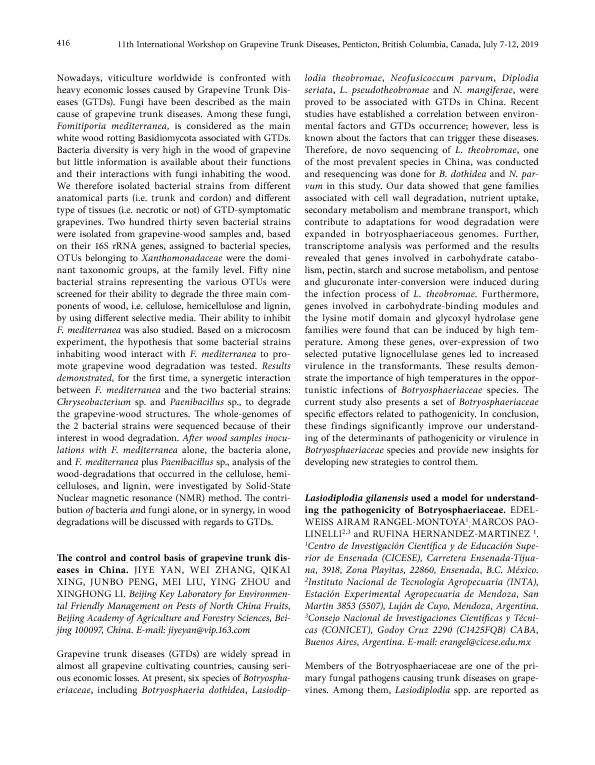Evento
Lasiodiplodia gilanensis used as model for understanding the pathogenicity of Botryosphaeriaceae
Tipo del evento:
Workshop
Nombre del evento:
11th International Workshop on grapevine trunk diseases
Fecha del evento:
07/07/2019
Institución Organizadora:
Oregon Wine Research Institute;
Título de la revista:
Phytopathologia Mediterranea
Editorial:
Firenze University Press
ISSN:
0031-9465
e-ISSN:
1593-2095
Idioma:
Inglés
Clasificación temática:
Resumen
Lasiodiplodia spp. cause degenerative diseases, dieback and plant death in a wide range of woody plants. To understand the fungal behavior of the genus we are using Lasiodiplodia gilanensis as a model. A transcriptional study revealed that the fungus is capable of using the phenylpropanoid precursors and salicylic acid to avoid the host defense response of the plant. On another hand, several genes encoding enzymes involved in different melanin synthesis pathways; 3,4-dihydroxyphenylalanine (DOPA)-melanin, 1,8-dihydroxynaphthalene (DHN)-melanin and pyomelanin; were identified and their production evauated, concluding that the fungus use diferent types of melanin to overcome environmental stress. An in silico analysis shows the presence of those genes in all the available genomes of Botryosphaeriaceae in the GeneBank, evidencing the importance of the melanin in this family. L. gilanensis produces siderophores of catechol and hydroxamate-type as well as naturally esterified fatty acids that might have a role in plant growth regulation. A plethora of hydrolytic enzymes is also produced, including xylanases, ligninases, cellulases, pectinases, cutinases, and hemicelluloses. Another secondary metabolite produced is oxalic acid, reported as a pathogenicity factor in other fungi, which role is under evaluation. Microscopical observations showed that the fungus uses the starch deposited in the ray cells as carbon source, induces the production of suberin and phenolic compounds and colonizes the vascular cambium, ray parenchyma, and the vascular bundles. These studies extend our understanding of the pathogenicity of a widely distributed pathogenic fungus with our final goal to control the diseases it causes.
Palabras clave:
PCWDEs
,
polyphenolic
,
Tyrosine catabolism
,
melanin
Archivos asociados
Licencia
Identificadores
Colecciones
Eventos(CCT - MENDOZA)
Eventos de CTRO.CIENTIFICO TECNOL.CONICET - MENDOZA
Eventos de CTRO.CIENTIFICO TECNOL.CONICET - MENDOZA
Citación
Lasiodiplodia gilanensis used as model for understanding the pathogenicity of Botryosphaeriaceae; 11th International Workshop on grapevine trunk diseases; Penticton; Canadá; 2019; 416 - 417
Compartir
Altmétricas




